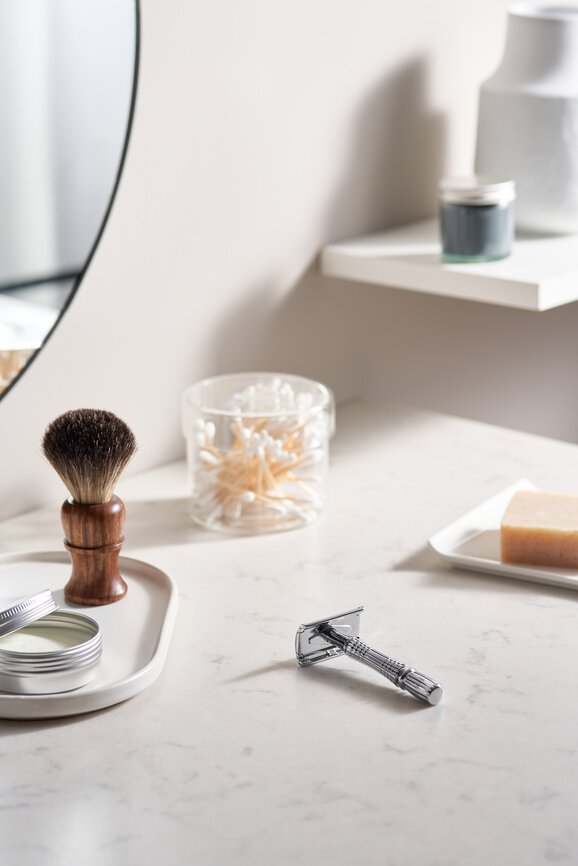
Scared Of Using A Safety Razor? I Was Too—Now I Love It
An Intro To Zero Waste Shaving
Shaving, for me, is like washing my car. I love the shiny outcome, but I don’t care enough to do it more often. It’s not new: I had hip surgery when I was seventeen, and no joke, the nurse asked the surgeon if I could “keep my fur for the winter.”
But I recently made the switch to using a safety razor, which is marginally scarier than a disposable razor, yet more accessible than a straight razor. I had dragged my feet (and my hairy legs) when it came to buying one, but now that I’ve found it, I’m never going back to disposable razors.
“I had dragged my feet (and my hairy legs) when it came to buying a safety razor, but now that I’ve found it, I’m never going back to disposable razors.”
I used to shave with cheap bottom-shelf razors—or, if I was feeling extravagant, I splurged for store-brand “Venus” equivalents. Even then, I used the same dulled-down razor longer than recommended to avoid the cost of new ones (and to avoid so much waste). I was a walking razor burn.
One day, after ordering another cringeworthy $25 blade refill pack for my husband’s shaving kit, I reached a breaking point. I’d had enough of the waste and of the expense (the pack came out to nearly $3 a head). I ordered myself a safety razor right then and there. My husband joined the party a few weeks later.
How To Choose A Safety Razor
I purchased my safety razor from the online retailer that shall-not-be-named for a cool $17 (it was this one—I really like it, and so do other people). While there are plenty of other options, I’m currently on a budget and this one fits the bill. Plus, I justified, I would no longer be purchasing disposable razors, so the purchase felt sustainable enough. If you’d rather support a smaller business, check out these Amazon alternatives. Here are some great options for straight razors specifically:
EcoRoots Rose Gold Razor ($36)
Maapilim Razor ($52)
Leaf 3-Blade Razor ($79)
If you’re picky, scout out independent review sites to get the best possible razor. It’ll likely be the last one you buy for a long time, so know what you want before ordering. Even though my razor isn’t the most beautiful, it’s affordable and functional—my top priorities for nearly everything in life.
How To Use A Safety Razor
Every time I talk about my new shaving tool, people get squeamish. “I could NEVER use one of those!” and “Aren’t you afraid of cuts?” are the two most common responses. The answers to these: yes, you are capable of using one. And also yes; I feared greatly for my legs the first time I used my safety razor.
Before I started, I watched YouTube videos and got familiar with the weight of the device in my hand. The handle is quite heavy by design, so I can rely on that weight instead of measuring the pressure to apply on my own. (A relief, since applying the wrong amount of pressure can lead to injury.)
“The steel blades come in small boxes, and you unwrap them from tiny paper envelopes, like little gifts.”
Blade installation is easy—and maybe even fun? The steel blades come in small boxes, and you unwrap them from tiny paper envelopes, like little gifts. My razor has a screw function that opens up the top, like a butterfly, making it easy to clean and safely replace blades. Used blades go into a secure container (called a blade bank), so they can’t cause injury when they’re recycled. You can purchase them if you’d like, but some users recommend free, upcycled options like Altoids tins.
When I shaved the first time with my safety razor, I moved slowly, deliberately, and aimed for a safe shave over a close one. I got a nick or two in my usual places, but still ended up with a delightfully close shave. Being generous with the shaving cream or soap helps me slow my pace and be more precise in my shave.
“When I shaved the first time with my safety razor, I moved slowly, deliberately, and aimed for a safe shave over a close one.”
As you get used to it, you can move a little bit more efficiently, although I can’t say it’s a speedy process. Each shave is closer than the one I’d get with cheap razors, and the blades are so affordable that I can change them out more frequently without worry (I get mine in a pack of 100 for less than $7).
What Can You Shave With A Safety Razor?
Emboldened by the success of shaving my legs, I moved on to all the other places I wanted to be hair-free. My preferences change frequently, so my shaving routine varies depending on my mood.
At the time of writing, I’m not shaving anything except—drumroll—my neck. I have PCOS and experience thick, dark hair growth on my neck and on the edge of my chin. It’s taken me years of picking and plucking to come to terms with it; now, with a more polished shaving routine, I embrace it. It was actually my level of enthusiasm about using a safety razor to shave my face and neck that convinced my husband to get a safety razor for himself.
“I’ve used it for my bikini area as well, and find it more comfortable and effective than disposable razors.”
I’ve used it for my bikini area as well, and find it more comfortable and effective than disposable razors. Gone are the days of hiding razor burn when I’m in a swimsuit!
The only body part I’m still uneasy about shaving is actually my armpits—there are just so many nooks and crannies. I’ve had some success shaving there, but I’m not fully confident and comfortable just yet. It’s all about practice.
Safety razors aren’t as scary as you think they are. If you’re looking for an “easy win” when it comes to living more sustainably, this is it. No matter when, where, and how you shave, it only takes a little learning and practice to successfully use a safety razor.
“If you’re looking for an ‘easy win’ when it comes to living more sustainably, this is it.”
Ready to get started? You can check out our guide to zero waste shaving products here. If you still have questions, ask them in the comments below and I’ll walk you through my experience!
RELATED READING
Emily Torres is the Managing Editor at The Good Trade. She’s a Los Angeles transplant who was born and raised in Indiana, where she studied Creative Writing and Business at Indiana University. You can usually find her reading or writing, caring for her rabbits, or practicing at the yoga studio.

